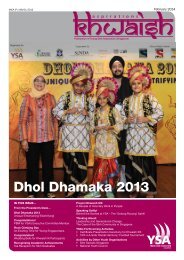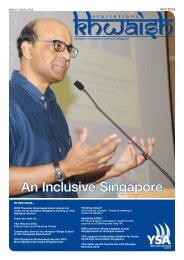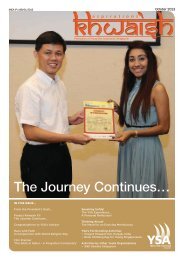ISS-Magazine_v7
You also want an ePaper? Increase the reach of your titles
YUMPU automatically turns print PDFs into web optimized ePapers that Google loves.
The Position of Women in Sikhism<br />
Harsimar d/o Gurdip Singh 1<br />
Sikhism is one of the few religions to describe God as gender neutral. Thus, in Sikhism, women are accorded the<br />
same status as their male counterparts. In Sikh ideology, there are no differences between males and females as both<br />
are considered to be spouses of the Eternal Lord, Suhagins, as the gender difference perishes with the physical body.<br />
(Prahlad Singh, 1999: 74) Through equal rights of amrit (holy nectar) initiation and by declaring them as equal spouses<br />
of the Eternal Lord, Sikh women have been relieved of these barriers of gender bias. The first Guru of the Sikhs, Sri<br />
Guru Nanak Dev Ji, laid the foundation for the equality of women. A notable social reform achieved by him was the<br />
emancipation of women. (Pruthi & Sharma, 1995: 1) For him, men and women were equal not only before God but also<br />
before one another. He rebutted the practice in the Hindu and Muslim faiths that saw women as lower in position and<br />
professed that they have to be on the same platform.<br />
Elevating women to the same platform as men, Sikhism also strived to end the atrocities committed upon them,<br />
especially in India. Sri Guru Nanak Dev Ji and his successors strongly condemned female infanticide that was rampant<br />
in India during that period of time. Hence, gender equality effectively ended female feticide within Sikhism and also saved<br />
widows from being compelled to live a life of deprivation. Similarly, women have the liberty to perform all religious tasks<br />
in the gurdwara (Sikh temple). There is no task or religious function from which women are barred from participating in<br />
or attending at any point of their lives. (Anand, 1996: 38)<br />
Even in Sri Guru Granth Sahib Ji, many teachings on the role of women can also be found. There are many other quotes<br />
and verses that sing the praises and equal treatment of women. In history as well, there are many women who till this<br />
day symbolise bravery, valour and self-sacrifice, values usually associated with their male counterparts. (Prahlad Singh,<br />
1999: 75)<br />
Thus, as portrayed in the teachings of its Gurus, its ideology and in its history, women have been given the same status<br />
as males in every aspect of Sikhism. Perhaps, the biggest accolade that can be awarded to women is described in Sri<br />
Guru Granth Sahib Ji which shows the clear teachings of gender equality in Sikhism. The verse is as follows:<br />
“Thou O Lord, art my Father and Thou my Mother. Thou art the Giver of peace to my soul and very life.” 2<br />
This verse shows that in Sikhism, God is both masculine and feminine and that His qualities can be found in both a<br />
mother and a father. Sikh women are not subservient to men in any field and are accorded equal status and respect.<br />
Endnotes<br />
1. The article is part a chapter of an Honour thesis submitted by Ms Harsimar Kaur d/o Gurdip Singh as part of her requirement for<br />
the Degree of Bachelor of Social Sciences (Honours) to the Department of Sociology, National University of Singapore (2002/03).<br />
The thesis is titled “Three Generations of Sikh Women”.<br />
2. See http://www.sikhs.org/women_q.htm.<br />
References<br />
Anand, T. K. 1996. The Essence of Sikhism. New Delhi: Madhuban Educational Books.<br />
Pruthi, Raj & Sharma, Bela Rani. 1995. Sikhism and Women. New Delhi: Anmol Publications Pvt. Ltd.<br />
Singh, Prahlad. 1999. “Blest are the Sikh Women” in Abstracts of Sikh Studies, Vol. 1, Issue 3, July-September. Ed. Dr. Kharak Singh.<br />
Chandigarh: Institute of Sikh Studies. Pp 72-77.<br />
8

















